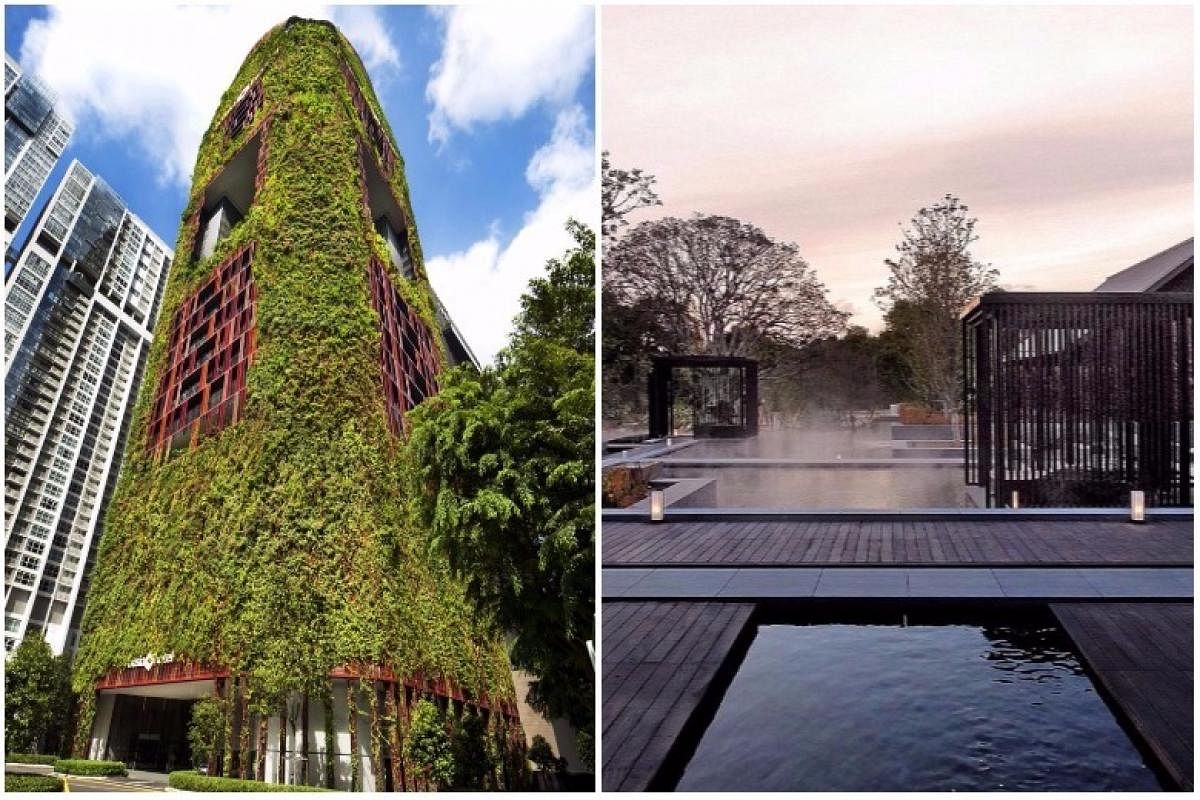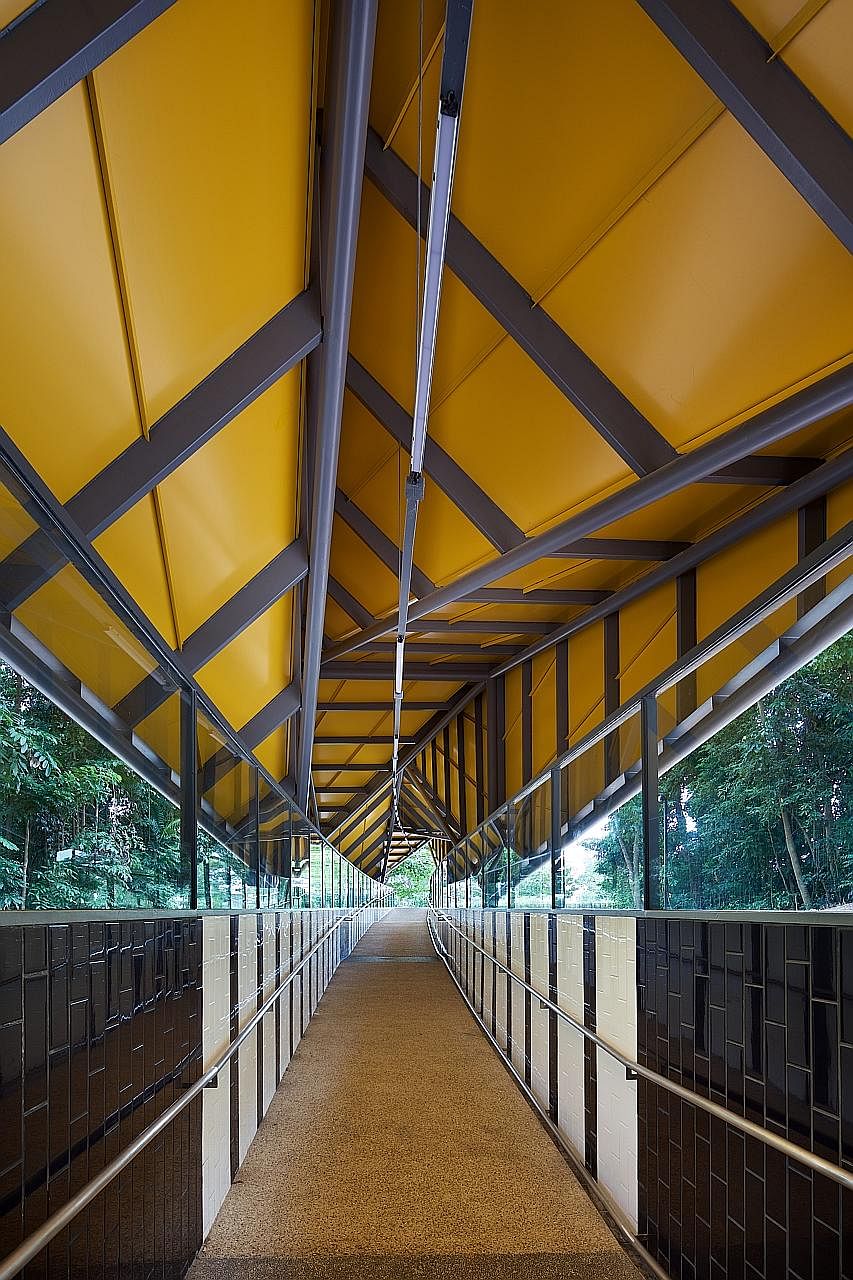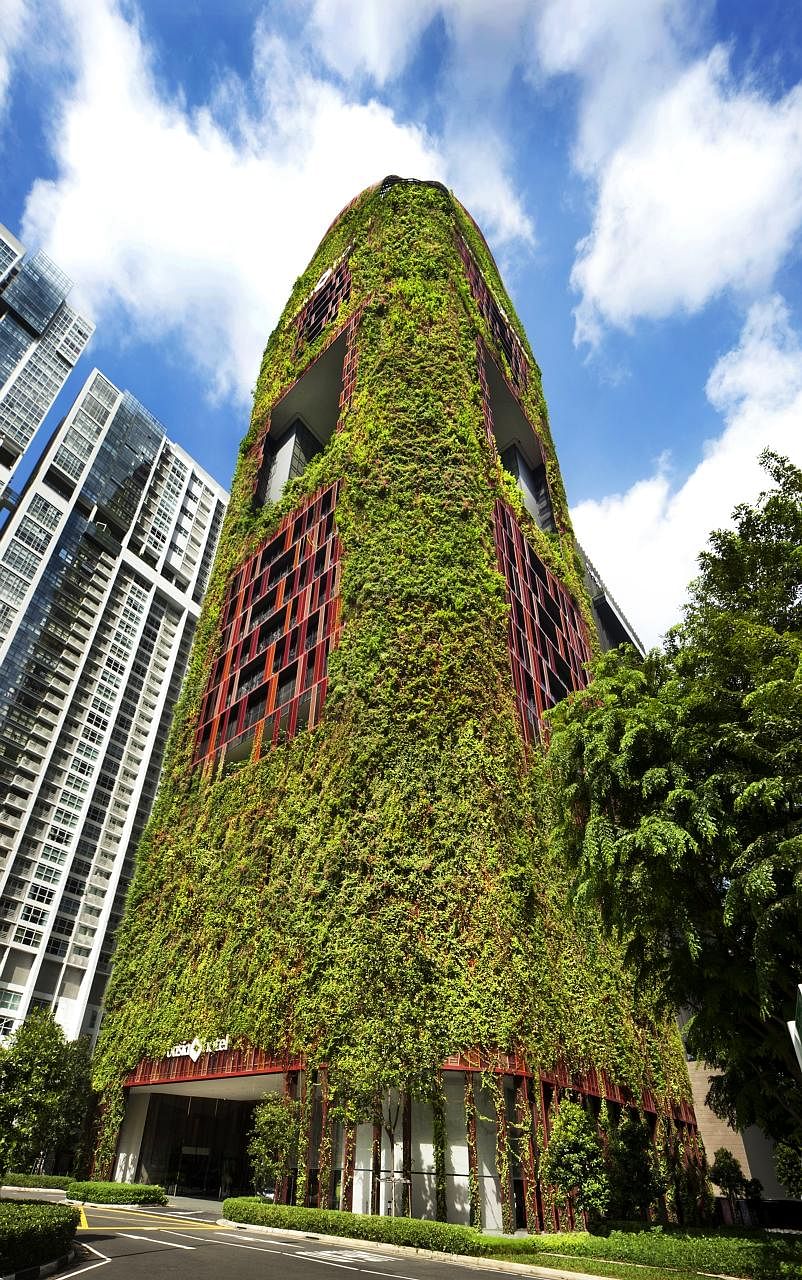Oasia Hotel Downtown, luxury resort Amanemu clinch top prize at the SIA Architectural Design Awards
Winners at the Singapore Institute of Architects Architectural Design Awards include a resort and onsen spa, hotel, an underpass and a light installation

Amanemu is a luxury resort and onsen spa while Oasia Hotel Downtown is a mixed-use development comprising a hotel and office spaces.
The former is conceived as a contemplative retreat nestled on an island in Japan, while the latter is located right in the heart of Singapore's Central Business District.
These two diverse works of architecture now hold the same accolade: Both have been awarded Building Of The Year - the top prize from the architecture fraternity here - at this year's annual Singapore Institute of Architects (SIA) Architectural Design Awards.
The double win is an uncommon occurrence in the history of the awards, which is into its 17th edition. Usually, there is just one recipient for this top accolade.
The two winning projects were picked by a five-member jury that included Mr Ashvinkumar Kantilal, past president of SIA; and Professor Ho Puay Peng, head of the architecture department at the National University of Singapore.
Mr Ashvinkumar says the two entries were "exceptional" and that the judges "unanimously" felt they were both deserving of an award each.
"Both projects were different in nature and scale, but they brought along with them so much delight and high standards of design," he says.
According to the jury's citation for Amanemu, which was helmed by Kerry Hill Architects, judges were impressed by the architects' skilful use of light, lines and colours, all of which contributed to the work's "impressive aesthetic purity and ability to capture the spirit of the place".
Architecture firm Woha, which spearheaded the design of the Oasia Hotel Downtown project, was lauded by the judges for its architects' ability to craft intimate public spaces within the 27-storey high-rise building and for successfully implementing the idea of tropical integration in modern cities with its lush green facade.
Both these developments first bagged a design award in the Commercial Projects category before being considered for the top prize.
Two projects also clinched awards in the Special Categories category: light installation Rhizome House by DP Architects and Bayshore Park Underpass by GreenhilLi.
In total, 11 awards were given out at the ceremony on Thursday night - two for Building Of The Year, four design awards and five honourable mentions.
These design awards are the profession's highest recognition of works that showcase excellence in architectural design.
It drew 105 entries this year, up from last year's 91.
But while there were 13 design awards and 14 honourable mentions last year, this year's number of award winners is significantly smaller.
When asked about the lean crop, Mr Ashvinkumar says: "There is no restriction in the judging process, in terms of having to give an award in every category or having to meet a certain number of awards."
The judging criteria, according to SIA, include how original and innovative the designs are, their sustainability and how well they respond to users' needs and the climate.
Soak in luxurious baths

Building Of The Year winner and Design Award winner for Commercial Projects: Amanemu by Kerry Hill Architects
Perched on the shores of the stunning Ago Bay, the Bay of Pearls that oyster divers plunge into, and positioned near the famed Kumano Kodo pilgrimage trails and the Ise Grand Shrine - Japan's most sacred shrine - is Amanemu, a luxury resort and onsen spa in Japan.
Conceived as a contemplative retreat with 24 guest suites and four villas, it boasts architectural details that are elegant and sensuous.
This architectural masterpiece, located about 300km south-west of Tokyo, was conceived by Kerry Hill Architects and clinched the top Building Of The Year prize at the Singapore Institute of Architects Architectural Design Awards this year.
This same firm also won a design award at last year's awards, for the luxury urban hotel Aman Tokyo.
Amanemu is the 12th hotel for hotel group Aman Resorts completed by the firm and it has another three more in construction.

This award-winning work blends traditional and modern design, with contrasting blond wood, dark stone materials and warm lighting.
Inspired by the steeply pitched, clay-tiled roofs and stained cedar walls of traditional farmhouses ("minka"), in which the locals live, the resort captures the essence of local building traditions and minimalist Japanese aesthetic.
Each suite, designed to look like a finely crafted timber box, comes with private onsen baths and offers expansive views of the bay.
All furniture is bespoke.
White oak tables are complemented by neutral-toned fabrics and soft furnishings in subdued hues of grey, blue, orange and brown to reflect the changing colours of the seasons, says Mr Kerry Hill, founder of Kerry Hill Architects.
The Amanemu spa houses a gym, treatment rooms and private onsen pavilions in a tranquil garden setting.
Here, the architecture extends into the landscape through stone-paved courtyards, timber decks and relaxation pavilions - all of which frame steaming mineral pools fed by natural hot spring water.
"The spa's central outdoor space embraces the theme of water - water to see, water to feel, water to hear, or silence," says Mr Hill.
Plastic fantastic

Design Award winner for Special Categories: Rhizome House by DP Architects
What at first glance looks like colourful and super-sized pieces of ginger trapped within a house is in fact a playful light installation by design firm DP Architects.
Rhizome House, as it is called, showcases giant rhizome structures that are encased in steel frames shaped like Dutch canal houses and lit up by about 865 colourful light diodes.
For its inventiveness and interactive approach to design, among other features commended, this work was given a design award at the Singapore Institute of Architects Architectural Design Awards.
The rhizome-like structures are made of recyclable and translucent industrial-grade plastic, which allows light to shine through.
The installation was an exploration of a new method of construction in which the processes of computational design, digital fabrication and mass customisation were utilised.
Conceptually, Rhizome House is envisioned as a stage for interaction.
Ms Angelene Chan, chief executive officer of DP Architects, explains that the nature of the rhizome shapes creates pockets of space within the volume, as well as arms that extend out towards viewers.
"We wanted the work to connect and engage with all peoples from all places, of all ages," says Mr Joe Krentz, associate at DP Architects.
The work debuted at the fifth edition of the Amsterdam Light Festival, which ran from Dec 1 last year to Jan 22.
During the festival, the design team observed that the installation was used as a dance stage, a jungle gym, a playground for children and a place to pose for photos - all of which are part of the work's goal of facilitating public engagement.
Ms Chan says of the award-winning work: "This validates the idea that architecture, design and construction are industries that need to be pushed and constantly innovated."
This is the first time DP Architects has created a light installation and the firm is already in the process of creating others.
Rhizome House is heading to Norrkoping in Sweden for the 2017-2018 edition of the Norrkoping Light Festival later this year.
There are no immediate plans to display the work here.

Underpass gets a lively update
Design Award winner for Special Categories: Bayshore Park Underpass by GreenhilLi
The Bayshore Park Underpass is described in the jury citation as an architectural work that is fun, joyful and rhythmic. It connects residential developments on the north side of the East Coast Parkway expressway to East Coast Park and the beach on the other side.
Designed by architecture firm GreenhilLi, this work won a design award for Special Categories.
The underpass was opened to the public in late 2015.
Ms Li Sau Kei and Mr Nigel Greenhill, who led their team of architects for this project, say it was "very gratifying" to have won an award "for a small project such as this".
"In our practice, we place great importance on design quality, regardless of the building size."
The judges applauded the architects' ability to transform a utilitarian underpass, which used to consist only of stair access and a dark tunnel, into architecture of significance.
The underpass now features the use of bright colours and dynamic forms, which create a sense of movement through space.

The chrome yellow roof that encloses the underpass is visually stunning. Rotating square frames which resolve into triangular planes twist along and above, like a giant origami snake.
Below ground, the walls of the underpass are finished in durable black and white tiles arranged in a bold vertical "bar-code" pattern, which creates a sense of movement as pedestrians walk through it.
When they emerge on the other side, all ready for play and recreation, the natural light and lush surrounds of the East Coast Park are revealed.
The transition is complete - one has left the city and entered the world of sand, sea and sky.

Green living in the city
Building Of The Year winner and Design Award winner for Commercial Projects: Oasia Hotel Downtown by Woha
From the heart of Singapore's Central Business District rises an innovative 27-storey building enveloped by a red aluminium mesh.
The silhouette of the scarlet-hued bower structure is softened by the presence of more than 20 species of creepers growing across the entire 200m-high facade. Awash in green, this is an architectural piece of work that was created to stand out against the grey and harsh-looking downtown skyscrapers.
The work has made more than just a visual impact. For its efforts, architecture firm Woha won Building Of The Year for designing Oasia Hotel Downtown at this year's annual Singapore Institute of Architects Architectural Design Awards.
Design for the project began in February 2011 and construction a year later. It was completed and opened in April last year at a cost of about $138 million.
Impressive appearance aside, this mixed-use development, comprising a hotel and office spaces, is meant to delight its occupants, guests and neighbours.
There are four Sky Terraces in the building, each of which offers panoramic views.
The first terrace, on the sixth storey, houses meeting pods, pantries, a gym and a pool - all of which can be enjoyed by offices located between the seventh and 11th storeys. The other three terraces - on the 12th, 21st and 27th floors - are meant for hotel guests. They come with lounges, lawns, pools and dining areas, among other amenities.
These Sky Terraces, vertical greening and internal breezeway atriums are part of the architects' vision to create a new kind of skyscrapers - one that offers generous green spaces while being suited for the local climate.
Mr Wong Mun Summ, one of Woha's founding directors, says: "We are interested in how skyrise greenery can transform not just a building, but also an entire neighbourhood by creating visual relief and promoting biodiversity.
"With its lush greenery and open volumes, the tower demonstrates a sustainable, humane and liveable approach to building in the city."
Join ST's Telegram channel and get the latest breaking news delivered to you.
A version of this article appeared in the print edition of The Straits Times on October 07, 2017, with the headline Oasia Hotel Downtown, luxury resort Amanemu clinch top prize at the SIA Architectural Design Awards. Subscribe

